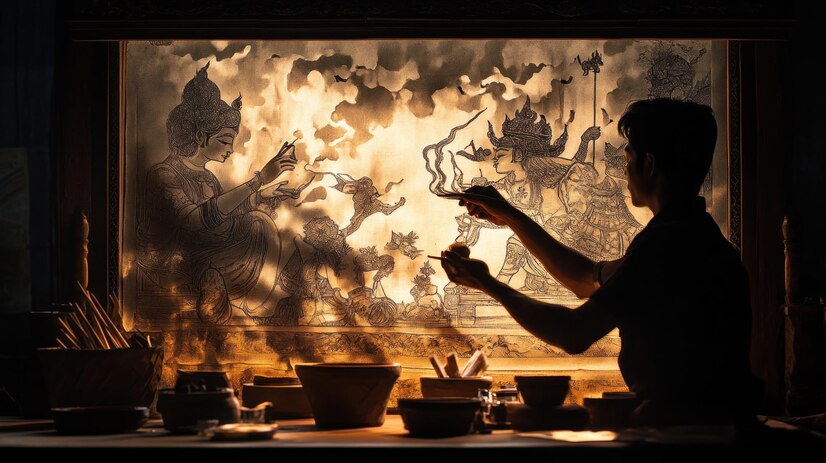In today’s fast-paced digital age, the subtle charm of ancient art often fades into obscurity. Yet, for those who take the time to look back, these relics offer a glimpse into the past—a testament to human creativity and cultural diversity. This blog post invites you on a captivating exploration of Ancient Artz, showcasing the revival of lost techniques and their significance in preserving cultural heritage.
The Timeless Allure of Ancient Artz
Art has always been a medium through which civilizations express their beliefs, values, and experiences. Ancient Artz, with its timeless allure, provides a window into the soul of bygone cultures. These works, ranging from intricate pottery and textiles to grandiose sculptures and murals, tell stories of societies long vanished. Recognizing their importance allows us to appreciate the roots that shape our present and future.
Unraveling Techniques of the Past
The techniques used by ancient artists were often passed down through generations, each one adapting and refining methods to suit their cultural context. With the resurgence of interest in these techniques, art historians and artisans alike are working diligently to preserve and revive these skills. By studying old texts, examining existing artifacts, and experimenting with materials, modern craftsmen are bringing lost traditions back to life.
The Role of Archaeology in Art Revival
Ancient Artz Archaeology plays a pivotal role in the revival of ancient art techniques. Excavations uncover hidden treasures that offer insights into artistic practices and cultural contexts. These findings, carefully analyzed by specialists, provide a foundation for reconstructing lost methods. Through collaboration between archaeologists and artisans, ancient art’s intricacies are meticulously revived, renewing cultural heritage for future generations to admire.
The Magic of Ancient Pottery
Pottery, often considered one of the oldest forms of art, showcases exceptional craftsmanship and innovation. Techniques such as coiling, glaze formulations, and firing methods are being rediscovered and practiced by contemporary artisans. These age-old practices not only produce stunning pieces but also connect us to the daily lives and spiritual practices of ancient civilizations.
Textiles Weaving Stories of the Past
Textiles tell tales of societies through their patterns, dyes, and weaving techniques. Ancient artisans mastered complex weaves and natural dyeing processes, creating vibrant fabrics that symbolized identity and status. Today, textile artists and historians are reviving these methods, ensuring that the stories interwoven into each fabric endure.
Sculpture’s Enduring Legacy
Sculpture, with its ability to capture lifelike forms and emotions, remains a powerful medium of expression. Ancient sculptures, ranging from colossal deities to delicate figurines, reflect the religious and societal values of their creators. Modern sculptors draw inspiration from these works, merging traditional techniques with contemporary sensibilities.
Painting a Window to the Past
Paintings, whether adorning cave walls or temple ceilings, provide a vivid depiction of life and mythology in ancient times. Techniques such as fresco, tempera, and encaustic painting reveal the ingenuity of early artists. By studying and practicing these methods, today’s artists continue to create evocative works that resonate with the past’s spirit.
The Cultural Heritage Connection
Reviving ancient art techniques isn’t just about preserving aesthetics; it’s about reclaiming cultural heritage. These endeavors foster a deeper understanding of our shared history, promoting respect and appreciation for diverse traditions. Engaging with ancient art enables communities to reconnect with their roots, instilling pride and continuity within cultural narratives.
Education and Workshops as Catalysts
Educational initiatives and workshops serve as catalysts for the revival of ancient art techniques. Universities, museums, and cultural organizations offer programs that teach traditional skills, ensuring that knowledge is passed to future generations. These opportunities enable budding artists to learn from masters, cultivating a new wave of artisans dedicated to preserving cultural heritage.
Technology Bridging Past and Present
Incorporating technology into the revival of ancient art offers exciting possibilities. Digital tools allow for precise reconstructions of artifacts, while virtual reality immerses audiences in ancient environments. These innovations bridge the gap between past and present, broadening access to cultural heritage and inspiring a global appreciation for ancient art forms.
The Role of Sustainability in Art Revival
Sustainability plays a crucial role in the revival of ancient art techniques. By using eco-friendly materials and traditional methods, artisans contribute to environmental preservation. This approach honors the resourcefulness of ancient craftspeople, who utilized local materials and sustainable practices long before sustainability became a modern imperative.
Building a Community Around Ancient Art
Communities built around the appreciation and revival of ancient art foster connections among like-minded individuals. Whether through social media groups, local clubs, or international networks, these communities share knowledge, resources, and inspiration. Together, they form a collective dedicated to keeping the spirit of ancient art alive.
A Call to Action for Cultural Preservation
The revival of ancient art techniques is not just a passion project for artisans and historians; it is a collective responsibility. We all play a role in preserving cultural heritage by supporting initiatives, attending exhibitions, and advocating for art education. By doing so, we ensure that the beauty and significance of ancient art continue to enrich our lives and inspire future generations.
Conclusion
Rediscovering Ancient Artz offers more than aesthetic pleasure—it connects us to the foundational stories of humanity. By reviving lost techniques and preserving cultural heritage, we honor the diverse tapestry of human expression. Join us in this endeavor, explore further resources, and become part of the movement to keep the legacy of ancient art alive.
FAQs
Q: Why is it important to revive ancient art techniques?
A: Reviving ancient art techniques is crucial because it preserves cultural heritage, provides insights into historical societies, and enriches contemporary artistic expression.
Q: How can individuals contribute to the preservation of ancient art forms?
A: Individuals can contribute by attending workshops, supporting artisans, and visiting exhibitions that focus on ancient art techniques. Additionally, participating in cultural initiatives and educating others about the importance of these art forms can help preserve them for future generations.
Q: What role does technology play in the revival of ancient art?
A: Technology plays a significant role by offering tools for precise reconstructions and facilitating virtual immersions into ancient environments. It broadens access to cultural heritage and inspires a deeper appreciation for ancient art forms through digital visualization and documentation.
Q: Are there any specific organizations dedicated to reviving ancient art techniques?
A: Yes, many universities, museums, and cultural organizations are dedicated to researching and teaching ancient art techniques. These institutions often host workshops and educational programs that aim to pass down traditional skills to new generations of artists.
Q: How can sustainability be integrated into the revival of ancient art?
A:This ensures that the revival efforts align with modern environmental considerations and honor the methods of ancient craftspeople.











Leave a Reply